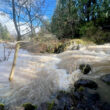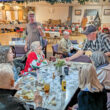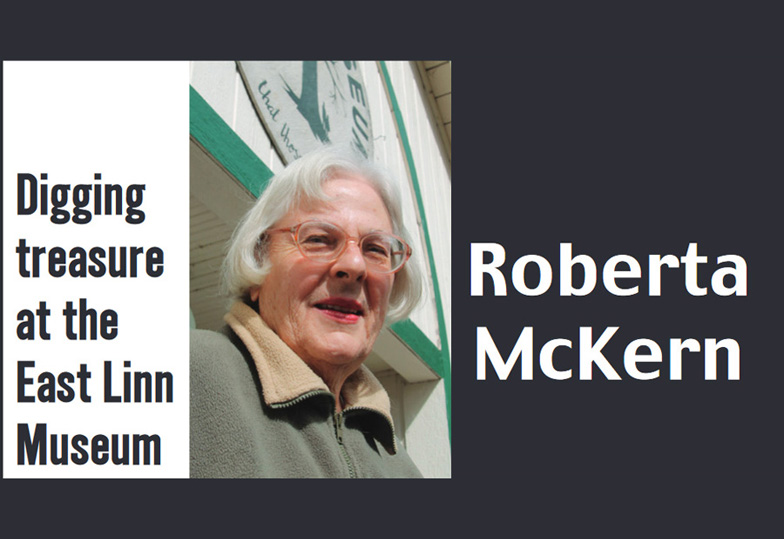By Roberta McKern
For The New Era
In association with the East Linn Museum, we have been looking at a 1917-18 Oregon Blue Book.
These books, still published, are collections of facts about the state, listing town populations, current post offices, and population numbers – in 1900 Sweet Home had 202 residents, for example.
We were looking for possible information about World War I which ended at the eleventh hour of the eleventh day in the eleventh month of 1918.
But the book was likely compiled before the war’s end, so not much was said. All men between 18 and 45 had to register for the draft, for instance.
Oregon men were serving in France with the Expeditionary Forces and others sailed on the Pacific and Atlantic with the Navy.
A real dividend was a brief history of the state featured at the front of the book.
Decades ago, many of us likely studied Oregon history in the eighth grade, which gave us a greater awareness of it when we were later vicariously reminded about it.
This Blue Book recalled the election of a provisional government at Champoeg back in 1843.
By then, the Oregon Country had been under the joint control of Great Britain and the United States for over 20 years, while the Canadian boundary between the two nations was undecided.
The press of American settlers traveling over the Oregon Trail to the Willamette Valley would help decide the issue. Already, emigrants had sent two petitions to the Congress of the United States which were just tabled, likely in part because the settlers were few, maybe around 250 – too few people wanting too much.
But the 1843 Champoeg meeting held a new urgency. The richest man in the area had died without a will and without known heirs and something had to be decided regarding his debts and creditors.
Who was this man? Ewing Young, the leader of a cattle company which had brought 650-700 head of cattle to Oregon from California.
Why was this essential? As we know, the American colony sat in the shadow of the Canadian Hudson’s Bay Company, which controlled fur trade in the Willamette Valley and Oregon country in general. Many emigrants arrived on the east bank of the Willamette River with worn-out stock, if any, after journeying down the Oregon Trail where oxen had been depended on to pull many of the wagons.
Hudson’s Bay, under Dr. John McLoughlin, would rent a cow to a settler but not sell him one. Were milk cows included in this? And so, the settlers decided to bring their own cattle in from California.
Ewing Young was one of those intrepid adventurous types who fared well on the American frontier. He’d been a trader on the Santa Fe Trail going down to New Mexico, and he knew much of the southwest from having turned to trapping. He arrived in Oregon by way of California and knew the route by which cattle could be driven up from that Spanish-controlled area.
He rewarded himself by setting up a ranch on the west side of the Willamette River along Chehalem Creek, where his cattle ran wild after his death. (In the eighth grade we envisioned in wolves snapping at their heels.)
When he decided to build a still using a vat left behind from Nathaniel Wythe’s failed fish processing business, Young came afoul of both McLoughlin and the Methodist missionaries.
Alcohol, they pointed out, acted badly on the trappers and Indians who drank too much. And the missionaries had already organized a Temperance Society.
Young cheerfully destroyed the beginnings of his distillery and did not accept payment for his losses. Did he join the Temperance Society before dying without a will? There’s no word on it. It is simply more important that he died.
The tale the old Blue Book of the Champoeg meeting of 1841 leaves out the wolves and any other predators. It is an original secondhand version compiled by J. Quinn Thornton for the Oregon Historical Society over 20 years after the event.
However, he contacted all the participants of that meeting that he could find, and a list of the ones who voted for the provisional government and their birthplaces is included at the end of the story.
Just “Canada” is listed as the birthplace for the ones voting no. So, 102 men met at Champoeg to pass a provisional government.
On one side stood a group of French Canadians, former trappers for the Hudson’s Bay Company. Dr. McLaughlin had encouraged the retired trappers to move into the area with their half-breed wives and children to become farmers.
The French Canadians numbered 52. Schooled by Hudson’s Bay, they were expected to vote no, partly because the British or Canada might gain permanent control of the area. But if the Americans won, they might lose their property rights.
On the other side was a diverse group of men, 50 strong, which included Methodist missionaries, two Scots (one born at sea), five Englishmen, and one Irishman, plus American settlers and mountain men, almost all of whom were from northern states which would help shape the conservative nature of the provisional government. Bickering ensued.
A trial vote saw the French Canadians voting yes on the proposition by mistake. They were supposed to vote no.
A motion was made for the men to divide and be counted. Finally, Joe Meek, a well-known mountain man and adventurer, stepped up.
“Who is for the divide?” he thundered in a voice loud enough to challenge a grizzly bear. “Follow me.” And he formed a group of men.
Fifty French Canadians held to the Hudson’s Bay Company instructions, voting no.
Fifty-two diverse settlers, plus two French Canadians, voted yes. And so, Oregon got its provisional government with the aid of Etienne Lucier and Francois V. Matthieu.
Following the vote, the election of officers immediately selected Joe Meek as sheriff and Ewing Young’s estate would be decided.
Five years later, boundaries between the United States and Canada were settled, but it would take two or three more years before Congress would create a territorial government.
Remember those wolves haunting Ewing Young’s property and threatening wandering cattle? We weren’t delusional about them.
Checking with the general Oregon history book written by Charles H. Carey, LLD, we found the Champoeg meeting was really the second of two wolf meetings.
History is a foreign country, so it’s said, and old history books are only guides.
Yet, we must see J. Quinn Thornton’s tale of the Champoeg meeting as part of Oregon’s legendary past, along with the great migrations entering the territory with hundreds of settlers in the year immediately following the meeting.
Once the boundaries were secured and accepted, many retirees from the Hudson’s Bay Company, like Dr. John McLoughlin and those who had voted no on the provisional government proposition, became naturalized citizens of the United States.
As we know, McLoughlin, when head of the Hudson’s Bay Company in Oregon had shown enough sympathy for the American settlers by giving aid to them that he later was called “The Father of Oregon.”
In a few years, settlers would populate the fertile Willamette Valley, replacing its original inhabitants who had little immunity to diseases introduced by trappers, traders, and arriving emigrants.
A constant flow of people fleeing conflicts in Europe helped replenish the resulting growing population spreading toward Oregon from the East Coast and even the Midwest.
Nearly free land, ideals of equality and democracy helped fuel the flow.
A look at Linn County’s census records in the 1917-18 Blue Book lets us follow the continuous growth. In 1890 the county had a population of 16,265. By 1910, 22,662.
Census dates for the State of Oregon go back to 1860, when 52,465 people were recorded. Stepping ahead to 1910, it had grown to 672,765 and Oregon would be considered a rural state with slower population growth than the urban ones.
And yet, the number of those who decided the fate of the Oregon Country’s provisional government consisted of 102 men and it’s estimated that around 250 settlers were living in the shadow of the Hudson’s Bay Company on the east side of the Willamette River and its confluence with the Columbia where wolves and wildcats also lurked.
We can say J. Quinn Thornton’s version of the Champoeg story is of an acorn that grew into a still-standing oak.





